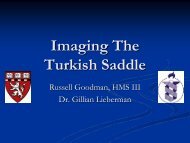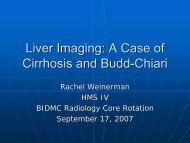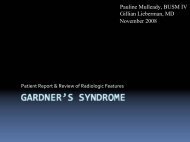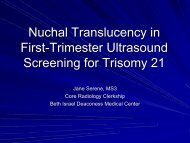The Basics of MRI: T1 vs. T2
The Basics of MRI: T1 vs. T2
The Basics of MRI: T1 vs. T2
Create successful ePaper yourself
Turn your PDF publications into a flip-book with our unique Google optimized e-Paper software.
Frank Minja, HMS III<br />
Gillian Lieberman, MD<br />
<strong>T2</strong> decay<br />
• When the parallel and anti-parallel magnetic moments fall onto the transverse<br />
plane they continue to precess around the vertical axis<br />
• Precession about the vertical axis<br />
• At time zero, all magnetic moments are in phase -Maximum <strong>T2</strong> signal<br />
• <strong>The</strong> local environment (local magnetic fields) will cause some magnetic<br />
moments to precess faster and some to precess slower. <strong>The</strong> magnetic moments<br />
fall out-<strong>of</strong>-phase (de-phasing)<br />
• Faster forward precession<br />
• Slower forward precession (reverse precession)<br />
• Since the net magnetic moment depends on direction, as more magnetic<br />
moments fall out <strong>of</strong> phase - the more they cancel each other out - the <strong>T2</strong> signal<br />
decays. This rate <strong>of</strong> cancellation = <strong>T2</strong> decay<br />
• Complete de-phasing <strong>of</strong> magnetic moments<br />
• <strong>T2</strong> decay curve<br />
• <strong>T1</strong> RELAXATION AND <strong>T2</strong> DECAY TOGETHER (repeat again!)<br />
8
















